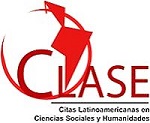Computer-mediated communication channels and their effects on communication satisfaction
DOI:
https://doi.org/10.33571/teuken.v12n18a10Keywords:
organizational communication, social networks, SMEs, computer-mediated communicationAbstract
Social networks are channels integrated into the internal organizational communication; therefore, the current study examines the use of computer-mediated communication and its possible effect on communication satisfaction in Colombian SMEs from the service sector; it also examines the percentage in which these channels are used. The sample is 103 people from 4 Colombian SMEs. The results show that WhatsApp, the E-mail, and the institutional Intranet are the most used internal communication channels, while Instagram, Facebook, and YouTube show the lowest percentage; likewise, it is observed that the absence of computer-mediated communication does not impact the communication satisfaction. The implications are essential at this time of global health emergency when organizations have been forced to move to the home office.
Article Metrics
Abstract: 745 PDF (Español (España)): 432PlumX metrics
References
Brandfog. (2016). CEOs, social media and brand reputation. Brandfog. http://brandfog.com/BRANDfog2016CEOSocialMediaSurvey.pdf
Brother International Corporation. (2019). Visión PYMES 2019: Colombia, Ecuador, Costa Rica and Panama. http://incp.org.co/Site/publicaciones/info/archivos/vision-pymes-2019-2552.pdf
Bughin, J. & Chui, M. (2013). Evolution of the networked enterprise: McKinsey Global Survey Result. McKinsey & Company. https://blog.euroforum.nl/wp-content/uploads/sites/11/2015/02/McKinsey-on-Impact-social-technologies.pdf
Creswell, J. & Creswell, J. (2018). Research design: Qualitative, quantitative, and mixed method approaches (5th ed.). Sage Publications, Inc.
Departamento Administrativo Nacional de Estadística – DANE. (2018). Censo Nacional de Población y Vivienda 2018. Gobierno de Colombia. https://www.dane.gov.co/index.php/estadisticas-por-tema/demografia-y-poblacion/censo-nacional-de-poblacion-y-vivenda-2018/cuantos-somos
Derks, D. & Bakker, A. (2010). The Impact of E-mail Communication on Organizational Life. Cyberpsychology: Journal of Psychosocial Research on Cyberspace, 4(1). https://cyberpsychology.eu/article/view/4233/3277
Downs, C. & Hazen, M. (1977). A Factor Analytic Study of Communication Satisfaction. The Journal of Business Communication, 14(3), 63-73. doi:10.1177/002194367701400306
Eurofound y la Organización Internacional del Trabajo – OIT. (2017). Trabajar en cualquier momento y en cualquier lugar: consecuencias en el ámbito laboral. Informe de investigación. https://www.ilo.org/wcmsp5/groups/public/---ed_protect/---protrav/---travail/documents/publication/wcms_712531.pdf
Ewing, M., Men, L. R. & O'Neil, J. (2019). Using Social Media to Engage Employees: Insights from Internal Communication Managers. International Journal of Strategic Communication, 13(2), 110-132. doi:doi.org/10.1080/1553118X.2019.1575830
Fuchs, C. (2014). Social Media: A critical introduction. SAGE Publications Inc.
Gay, L., Mills, G. E., & Airasian, P. (2012). Educational research: Competencies for analysis and applications (10th ed.). Pearson Education, Inc.
Guetzkow, H. (1965). Communication in organizations. In March, J. (Ed.), Handbook of organizations (534-573). Rand McNally.
Hackman, M. & Johnson, C. (2018). Leadership: A Communication Perspective (7th ed.). Waveland Press, Inc.
Iannarelli, J. & O’Shaughnessy, M. (2015). The Technical Side. In Iannarelli, J & O’Shaughnessy, M. (Edits.). Information governance and security: Protecting and managing your company’s proprietary information (91-136). Elsevier Inc.
Ibrahim, M. (2015). Model of E-Leadership, Intra-team Communication and Job Satisfaction among School Leaders in Malaysia. Mediterranean Journal of Social Sciences, 5(23), 1927-1931. doi:10.5901/mjss.2014.v5n23p1927
Jackson, M. H. (1996). The Meaning of “Communication Technology”: The Technology-Context Scheme. Annals of the International Communication Association, 19(1), 229-267. doi:10.1080/23808985.1996.11678932
Kaplan, A. & Haenlein, M. (2010). Users of the world, unite! The challenges and opportunities of Social Media. Business Horizons, 53(1), 59-68. doi:10.1016/j.bushor.2009.09.003
Khajeheian, D. (2018). Enterprise Social Media: Ethnographic Research on Communication in Entrepreneurial Teams. International Journal of E-Services and Mobile Applications, 10(1), 34-46. doi:10.4018/IJESMA.2018010103
Malhotra, N. (2010). Marketing Research: An Applied Orientation (7th ed.). Pearson Education, Inc.
Martins, H. & Ferro, M. (2008). Online Corporate Collaborative Teams. In Putnik, G. & Cruz-Cunha, M. (Edits.), Encyclopedia of Networked and Virtual Organizations (1.112-1.119). IGI Global.
McQuail, D. (2020). Mcquail's Mass Communication Theory (7th ed.). SAGE Publications.
Men, L. & Tsai, W. (2016). Public engagement with CEOs on social media: Motivations and relational outcomes. Public Relations Review, 42(5). 932-942. https://doi.org/10.1016/j.pubrev.2016.08.001
Ministerio de Tecnologías de la Información y las Comunicaciones. (2017, 28 de enero). Primera Gran Encuesta TIC 2017. Gobierno de Colombia. https://colombiatic.mintic.gov.co/679/articles-74002_cartilla_resumen.pdf
Ministerio de Tecnologías de la Información y las Comunicaciones. (2019, 14 de febrero). Functions. Gobierno de Colombia. https://www.mintic.gov.co/portal/604/w3-article-12965.html
Mumby, D. & Kuhn, T. (2019). Organizational Communication: A Critical Introduction (2nd ed.). SAGE Publications Inc.
OECD. (2017, 15 de mayo). Estudios Económicos de la OCDE: Colombia. http://www.oecd.org/economy/colombia-economic-snapshot/
Peñarroja, V., Orengo, V., Zornoza, A., Sánchez, J., & Ripoll, P. (2015). How team feedback and team trust influence information processing and learning in virtual teams: A moderated mediation model. Computers in Human Behavior, 48, 9-16. doi:10.1016/j.chb.2015.01.034
Putti, J., Aryee, S. & Phua, J. (1990). Communication relationship satisfaction and organizational commitment Studies. Group & Organization Studies, 15(1), 44-52. doi:doi.org/10.1177/105960119001500104
Redding, C. & Tompkins, P. (1988). Organizational communication-Past and future tenses. In Goldhaber, G. & Barnett, G. (Edits.), Handbook of organizational communication (5-34). Ablex.
Redding, W. C. (1978). Communication within the organization. New York: Industrial Communication Council.
Richter, D., Riemer, K., & vom Brocke, J. (2011). Internet Social Networking. Business & Information Systems Engineering, 3 (2), 89–101. doi:10.1007/s12599-011-0151-y
Robbins, S. & Judge, T.(2017). Organizational behavior (17th ed.). Pearson Education, Inc.
Safko, L., & Brake, D. K. (2009). The Social media bible: Tactics, tools, and strategies for business success (1st ed.). John Wiley & Sons, Inc.
Shannon, C. & Weaver, W. (1948). The Mathematical Theory of Communication. Bell System Technical Journal, 27(3), 379–423. doi:10.2307/2809977
Silver, L., Smith, A., Johnson, C., Taylor, T., Jiang, J., Anderson, M., & Rainie, L. (2019). Mobile Connectivity in Emerging Economies. Pew Research Center.
Steele, G., & Plenty, D. (2015). Supervisor-Subordinate Communication Competence and Job Communication Satisfaction. International Journal of Business Communication, 52(3), 294-318. doi:10.1177/2329488414525450
Stevens, P., Williams, K., & Michael, C. (2000). Organizational communication and information processes in an Internet-enabled environment. Psychology & Marketing, 17(7), 607–632. doi:10.1002/(sici)1520-6793(200007)17:7<607::aid-mar3>3.0.co;2-5
Thayer, L. (1975). Comunicación y sistemas de comunicación: en las organizaciones, en la gestión directiva y en las relaciones interpersonales. Irwin, Inc.
The University of Pécs Faculty of Economics (PTE KTK); Office of Management and Sciences (VSZI). (2020, 16 de junio). Second Farkas Ferenc International Scientific Conference. https://ktk.pte.hu/hu/tudomany/tudomanyos-rendezvenyek/farkas-ferenc-nemzetkozi-tudomanyos-konferencia/ii-konferencia
Thurlow, C., Lengel, L. & Tomic, A. (2004). Computer mediated communication: Social interaction and the internet (1st ed.). SAGE Publications Inc.
Tompkins, P. (1967). Organizational communication: A state-of-the-art review. In NASA, & G. Richetto (Ed.). Conference on organizational communication (4-26). National Aeronautics and Space Administration.
Tompkins, P. K. (1984). The functions of communication in organizations. In Arnold, C., Bowers, J., Arnold, C & Bowers, J. (Edits.). Handbook of rhetorical and communication (659-719). Allyn & Bacon.
Wang, V. (2011). Encyclopedia of Information Communication Technologies and Adult Education Integration (1st ed.). Taxmann Publications Private Limited.
Yukl, G. (2019). Leadership in organizations (9th ed.). Prentice-Hall.
Downloads
Published
How to Cite
Issue
Section
License
Copyright (c) 2021 Ever Bedoya

This work is licensed under a Creative Commons Attribution-NonCommercial-ShareAlike 4.0 International License.

























